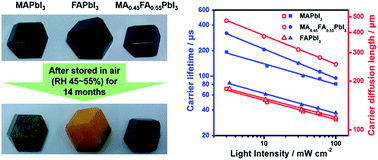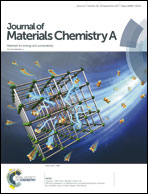A formamidinium–methylammonium lead iodide perovskite single crystal exhibiting exceptional optoelectronic properties and long-term stability†
Abstract
Halide perovskite single crystal of cubic HC(NH2)2PbI3 (FAPbI3) having excellent optoelectronic properties, such as narrow bandgap, large absorption coefficient and superior thermal stability has caught a surge of attention as a promising material for production of high-performance optoelectronic devices. However, at room temperature, the self-transformation of cubic FAPbI3 perovskite phase to non-perovskite phase leaves a critical roadblock to its practical viability. Herein, a simple alloying strategy by mixing methylammonium with formamidinium is developed to stabilize the FAPbI3 perovskite phase, hence achieving a highly stable mixed cation MA0.45FA0.55PbI3 perovskite single crystal over a span of 14 months. The MA0.45FA0.55PbI3 single crystal exhibits exceptional optoelectronic properties like high carrier mobility of 271 ± 60 cm2 s−1 V−1 and long diffusion length up to 254 μm, which are twice the values for sole MAPbI3 or FAPbI3 crystals. In addition, the photodetector based on MA0.45FA0.55PbI3 single crystal exhibits low detection limit of about 1 nW cm−2, high ON–OFF ratio of ∼1000, short response time of less than 200 μs, and impressive stability under aging in dark for 4 months or continuous photo-switching test for 1000 s.



 Please wait while we load your content...
Please wait while we load your content...